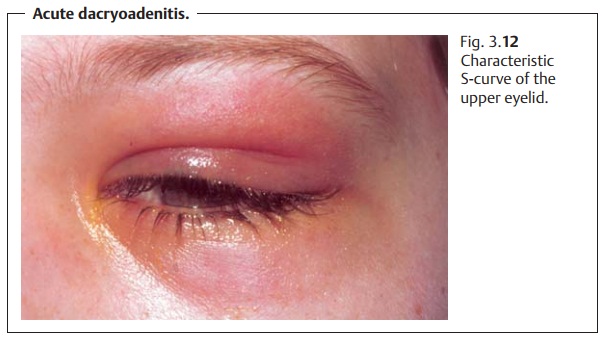Chapter: Ophthalmology: Lacrimal System
Disorders of the Lacrimal Gland

Disorders of the Lacrimal Gland
Acute Dacryoa
denitis
Definition Acute inflammation of the lacrimal gland is a rare disorder characterized by intense
inflammation and extreme tenderness to palpation.
Etiology: The disorder is often attributable to pneumococci and
staphylo-cocci, and less frequently to streptococci. There may be a
relationship between the disorder and infectious diseases such as mumps,
measles, scar-let fever, diphtheria, and influenza.
Symptoms and diagnostic considerations: Acute dacryoadenitis usuallyoccurs unilaterally. The inflamed swollen gland is especially tender to palpa-tion.
The upper eyelid exhibits a characteristic
S-curve (Fig. 3.12).

Differential diagnosis:
❖Internal hordeolum (smaller and circumscribed).
❖ Eyelid abscess (fluctuation).
❖ Orbital cellulitis (usually associated with reduced motility of
the eyeball).
Treatment: This will depend on theunderlying
disorder.Moist heat,disinfect-ant compresses (Rivanol), and
local antibiotics are helpful.
Clinical course and prognosis: Acute inflammation of the lacrimal gland ischaracterized by a rapid clinical course and spontaneous healing within eight to ten days. The prognosis is good, and complications are not usually to beexpected.
Chronic Dacryoadenitis
Etiology: The chronic form of inflammation of the lacrimal gland may be
theresult of an incompletely healed acute
dacryoadenitis. Diseases such as tuber-culosis, sarcoidosis, leukemia, or
lymphogranulomatosis can be causes of chronic dacryoadenitis.
Bilateral chronic inflammation of the lacrimal
and salivary glands is referred to as Mikulicz’s syndrome.
Symptoms and diagnostic considerations: Usually there is no pain. Thesymptoms are less
pronounced than in the acute form. However, the S-curve deformity of the palpebral
fissure resulting from swelling of the lacrimal gland is readily apparent (see
Fig. 3.12).
Differential diagnosis:
❖ Periostitis of the upper orbital rim (rare).❖ Lipodermoid (no signs of inflammation).
Treatment: This will depend on theunderlying
disorder.Systemic corti-costeroids may
be effective in treating unspecific forms.
Prognosis: The prognosis for chronic dacryoadenitis is good when the
under-lying disorder can be identified.
Tumors of the Lacrimal Gland
Epidemiology: Tumors of the lacrimal gland account for 5 – 7% of orbital
neo-plasms. Lacrimal gland tumors are much
rarer in children (approximately 2% of orbital tumors). The relation of
benign to malignant tumors of the lacrimal gland specified in the literature is
10:1. The most frequent benign
epitheliallacrimal gland tumor is thepleomorphic
adenoma. Malignant tumors include
the adenoid cystic carcinoma and pleomorphic adenocarcinoma.
Etiology: The WHO classification of 1980 divides lacrimal gland tumors
intothe following categories:
I. Epithelial tumors.
II. Tumors of the hematopoietic or lymphatic tissue.
III. Secondary tumors.
IV.Inflamed tumors.
V. Other and unclassified tumors.
Symptoms: Tumors usuallygrow very
slowly. After a while, they displace theeyeball inferiorly and medially,
which can cause double vision.
Diagnostic considerations: Testingmotilityprovides
information about theinfiltration of the tumor into the extraocular muscles or
mechanical changes in the eyeball resulting from tumor growth. The echogenicity
of the tumor in ultrasound studies is
an indication of its consistency. CT and MRI studiesshow the exact location and
extent of the tumor. A biopsy will confirm whether it is malignant and what
type of tumor it is.
Treatment: To the extent that this is possible, the entire tumor should
beremoved; orbital exenteration (removal of the entire contents of the orbit)
may be required. Systemic administration of corticosteroids is indicated for
unspecific tumors.
Prognosis: This depends on the degree of malignancy of the tumor. Adenoidcystic carcinomas have the most unfavorable prognosis.
Related Topics